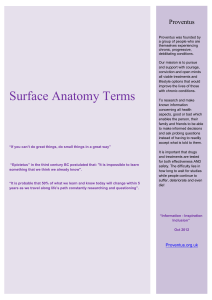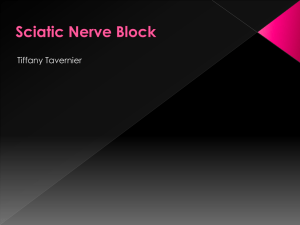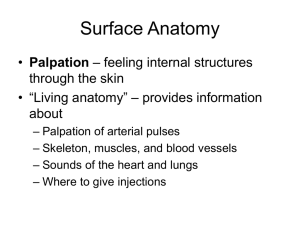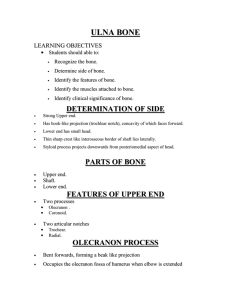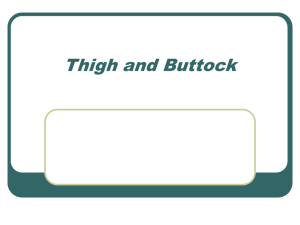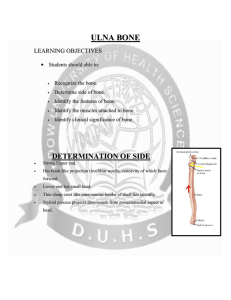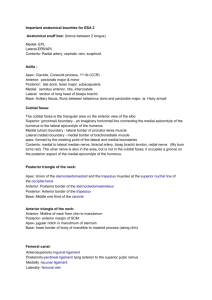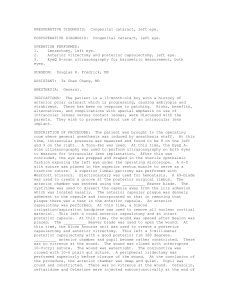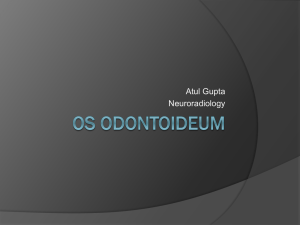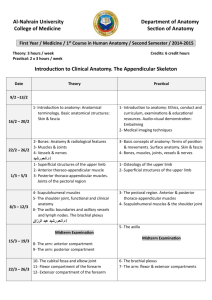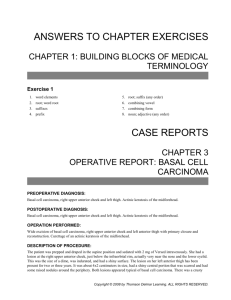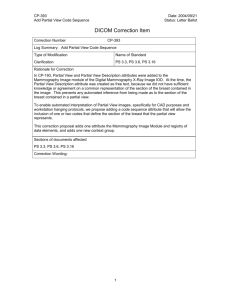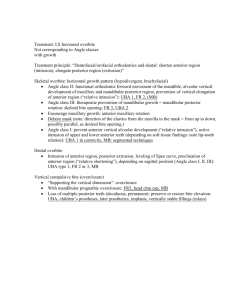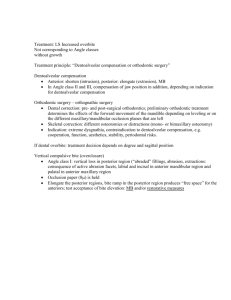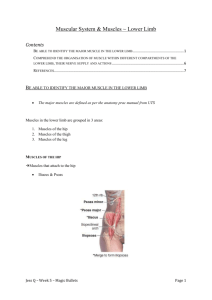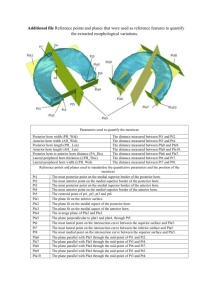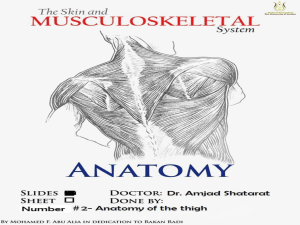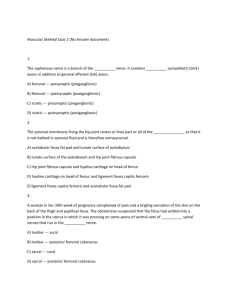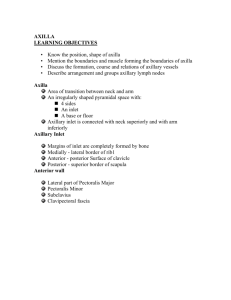neuroOct10
advertisement
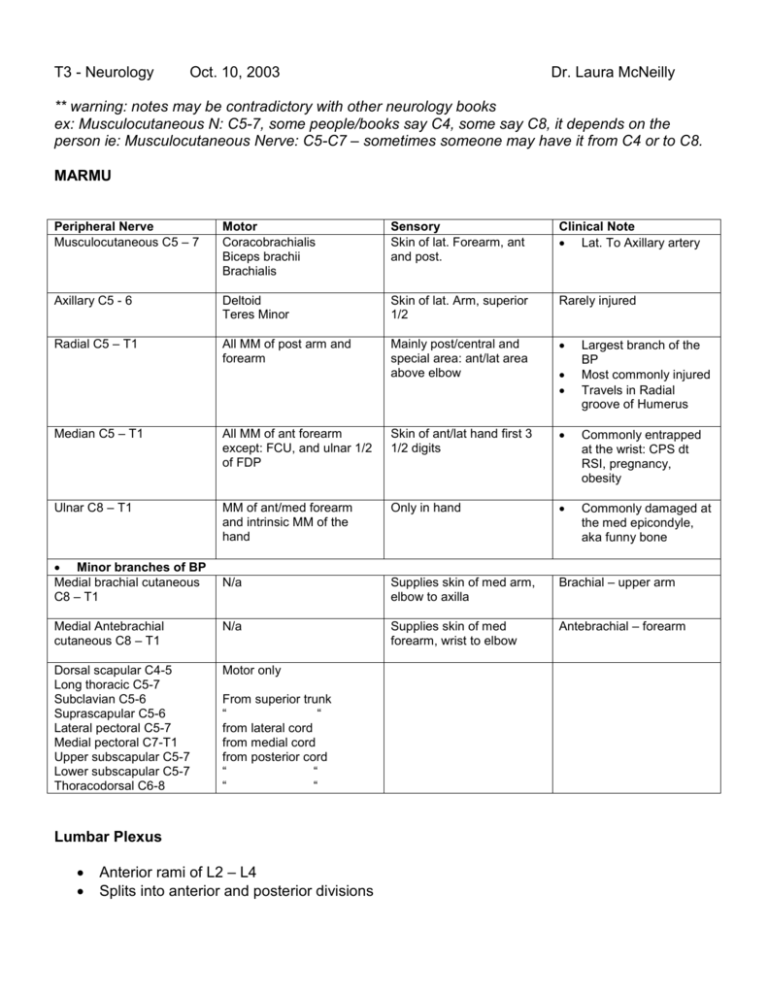
T3 - Neurology Oct. 10, 2003 Dr. Laura McNeilly ** warning: notes may be contradictory with other neurology books ex: Musculocutaneous N: C5-7, some people/books say C4, some say C8, it depends on the person ie: Musculocutaneous Nerve: C5-C7 – sometimes someone may have it from C4 or to C8. MARMU Peripheral Nerve Musculocutaneous C5 – 7 Motor Coracobrachialis Biceps brachii Brachialis Sensory Skin of lat. Forearm, ant and post. Clinical Note Lat. To Axillary artery Axillary C5 - 6 Deltoid Teres Minor Skin of lat. Arm, superior 1/2 Rarely injured Radial C5 – T1 All MM of post arm and forearm Mainly post/central and special area: ant/lat area above elbow Largest branch of the BP Most commonly injured Travels in Radial groove of Humerus Median C5 – T1 All MM of ant forearm except: FCU, and ulnar 1/2 of FDP Skin of ant/lat hand first 3 1/2 digits Commonly entrapped at the wrist: CPS dt RSI, pregnancy, obesity Ulnar C8 – T1 MM of ant/med forearm and intrinsic MM of the hand Only in hand Commonly damaged at the med epicondyle, aka funny bone N/a Supplies skin of med arm, elbow to axilla Brachial – upper arm Medial Antebrachial cutaneous C8 – T1 N/a Supplies skin of med forearm, wrist to elbow Antebrachial – forearm Dorsal scapular C4-5 Long thoracic C5-7 Subclavian C5-6 Suprascapular C5-6 Lateral pectoral C5-7 Medial pectoral C7-T1 Upper subscapular C5-7 Lower subscapular C5-7 Thoracodorsal C6-8 Motor only Minor branches of BP Medial brachial cutaneous C8 – T1 From superior trunk “ “ from lateral cord from medial cord from posterior cord “ “ “ “ Lumbar Plexus Anterior rami of L2 – L4 Splits into anterior and posterior divisions Anterior Division Gives rise to Obturator Nerve (L2 – L4) Peripheral Nerve Obturator Motor Medial thigh (adductors), inc’l groin, anterior 1/2 of Adductor Magnus Sensory Lower 1/2 of medial thigh Clinical Note Injured dt Pelvic fractures, MVA, horseback riding Peripheral Nerve Femoral (L2 – 4) Motor MM of anterior thigh, inc’l Sartorius and Pectineus Sensory Anterior thigh, knee cap, medial lower leg and medial foot. Clinical Note Exits pelvis via femoral triangle. Most commonly affected by Diabetic neuropathy Saphenous (branch of Femoral N) N/a Supplies medial lower leg Injured dt pelvic fractures, compression (preg., obesity) Nerve to Psoas (branch of Femoral N) Psoas Iliacus Quadratus Lumborum N/a Does not exit the pelvis, rarely injured Lateral Femoral cutaneous (branch of Femoral N) N/a Skin of lateral superior thigh Meralgia Paresthetica – painless loss of sensation over lateral hip (preg., obesity) Posterior Division Sacral Plexus Anterior rami split into anterior and posterior divisions L4 – S2 Anterior Division Peripheral Nerve Sciatic L4 – S2 Motor Sensory Clinical Note Consists of Tibial and Common Peroneal N Exits the pelvis through the Greater sciatic foramen Impingement if travels through Piriformis Descends in posterior thigh deep to hamstrings Splits superior to Popliteal fossa into Tibial and Com. Peroneal Can be damaged dt compression (sitting on a hard surface) Impingement can also be at the vertebrae because of a sacral tilt Tibial L4 – S2 All posterior thigh MM inc’l posterior 1/2 of Adductor Magnus, posterior lower leg and Biceps Femoris, long head. Skin of posterior lower leg, sole of foot and lateral foot Commonly damaged while passing around the medial malleolus (ankle sprain),k branches to Med & Lat Plantar nerves Posterior division Peripheral Nerve Common Peroneal L4 – S2 Motor Splits to: Superficial peronial Peroneus L/B Deep peronial rest of MM of lower leg and dorsum of foot Sensory Skin of anterior lower leg and dorsum of foot Clinical Note Enters anterior compartment by passing over head of fibula. Injured dt compression where it passes over fibula, by crossing leg, or tight boots. Gluteal L4 – S2 Splits to: Superior Gl. Medius and Minimus Inferior Gl. Maximus N/a N/a

